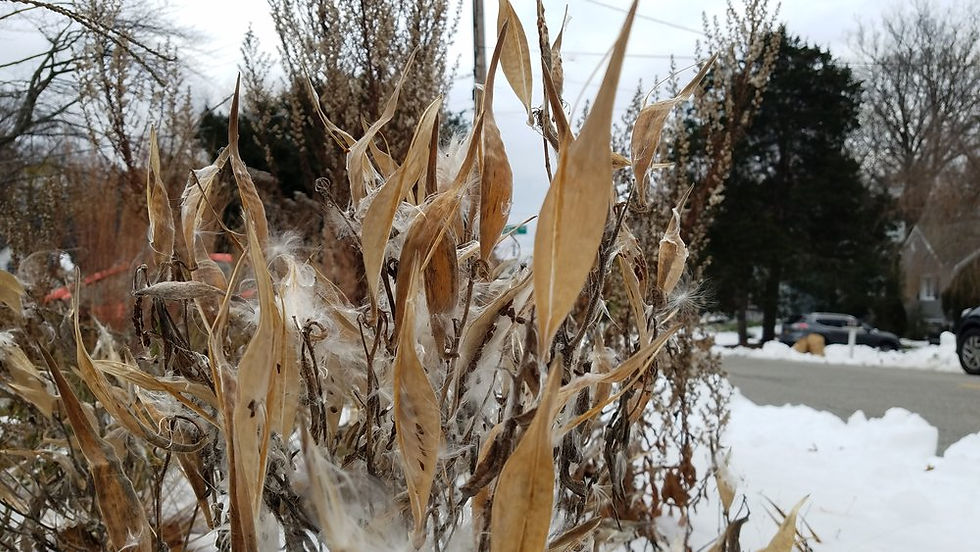Fall Garden Care for Pollinators
As we begin to think about putting our gardens to bed for winter, think about the winter habits of our friends the pollinators. Although many people still hold with the idea of cleaning the beds by trimming plants to the ground and covering everything with mulch, this is far from the best for the pollinators. Popular opinion is swinging toward letting things stay just as they are through winter—decayed and drab but serviceable. Now is the time to procrastinate and leave the stubble standing!
Thinking about winter care for our pollinators, we need focus mainly on one basic need, shelter. Here are how some of our pollinators find winter shelter.
Butterflies

Many often assume butterflies all fly south for the winter. Not so for many native species. Some butterflies have evolved the capability of producing anti-freeze which protects them if it gets below freezing. These include the comma (Polygonia c-album) and question mark (Polygonia interrogationis) butterflies who find a snug piece of bark or a dried leaf to nestle under until spring.
Other species overwinter as a chrysalis. These would include cabbage white (Pieris rapae), sulphurs (Phoebis spp.) and members of the swallowtail family (Papilionidae) all over winter as a chrysalis. Many of these chrysalises can be found either hanging from dead plant stems or tucked into the soil or leaf litter. You can guess what a fall gardening clean up does to them.
And still others spend the winter as a caterpillar. Examples would be red-spotted purple (Limenitis arthemis), meadow fritillary (Boloria bellona) and viceroy (Limenitis archippus) who hibernate among the vegetation, in seed pods, in silken nests, and in rolled-up leaves.
During mild spells, the caterpillars of some species will resume feeding. We don’t want to shut their buffet by trimming back all of the plants.
Bees
Standing plants are important for many species of bee. Several species of solitary bees hide in the hollow stems of plants such as bee balm. You can also install a bee hotel which is readily inhabited by mason bees. The young adults will spend the winter in diapause. Other bee species bury into the ground. This is why we should not cover the entire flower bed in mulch; we need to leave some bare areas. Make sure the bare areas are not on a slope however, otherwise you may experience erosion due to winter rain and snowmelt.
Beetles

Ladybugs are notorious pest eaters, each one consuming dozens of soft-bodied pest insects and insect eggs every day. Leaving the garden intact for the winter means you’ll get a jump start on controlling pests in the spring.
While the introduced Asian multicolored ladybug comes into our homes for the winter and becomes quite a nuisance, none of our native ladybug species have any interest in spending the winter inside of your house. Most of them spend the colder months tucked under a pile of leaves, nestled at the base of a plant, or hidden under a rock. Most overwinter in groups of anywhere from a few individuals to thousands of adults.
So What Should You Do in the Fall?
In some subdivisions, you might get a few comments about your garden looking too “natural”. If that is the case, clean up your front yard and let the pollinators enjoy your beds in the back.
So wait until spring before heading out with your pruning shears. Of course if you have ailing plants, remove those to help with disease control. Also remove any materials from the garden that might have fungus on it. However, if its simply dead, leave it alone.
If you would like to learn more about fall garden cleanup, you can attend our Pollinator Series. From 7 – 9pm, on Oct 15, 2019, we will be discussing this topic and more. To register for this free program, please contact Butler Soil and Water Conservation District at 513-887-3720 or butlerswcd@butlercountyohio.org.

If you’re not ready to kick your feet up and relax, you can help monarch’s by collecting milkweed seed pods. Butler Soil and Water Conservation District is the local drop off from Sept 1 – Oct 30 for common milkweed seed pods. Find out more at www.ButlerSWCD.org/pollinators Seed pods can be dropped off Mon-Fri between 8 am and 4:30 pm.


















